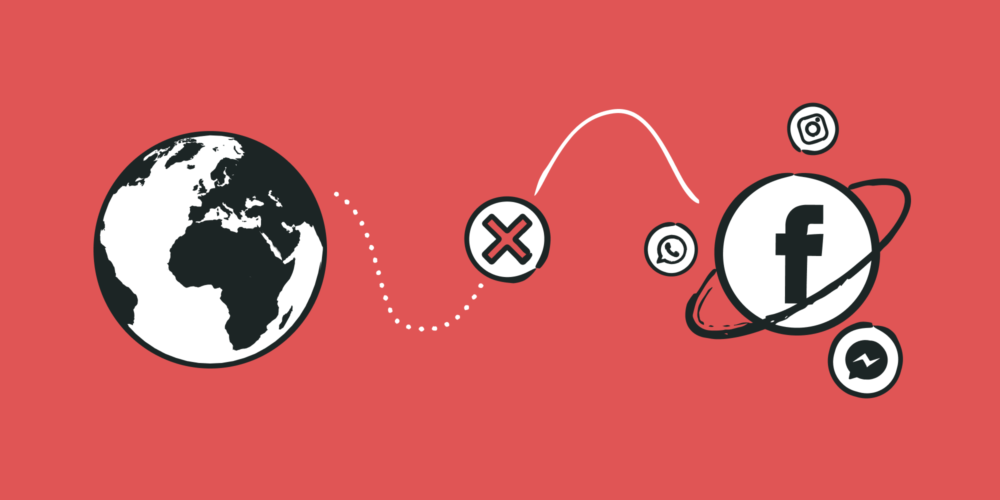If you were one of billions of frustrated users of Facebook who weren’t able to access their accounts Monday, rest assured in knowing that downtime is a thing of the distant past and the mega-social media platform is back online. End users can now relax knowing that the brush fire has been extinguished.
Remarkably, the nearly seven-hour outage could not be attributed to the deluge of recent high-profile attacks on government, enterprise, and educational servers throughout the world. Rather, Facebook engineers explained that the company’s data centers shut down during routine maintenance, causing the DNS servers to go offline resulting in 5xx server error messages to pop up everywhere.
DNS, or Domain Name System, is necessary for your users to be able to successfully navigate to your website and use your web services. Without it, users would need to memorize exact IP addresses in order to get from Point A to Point B on the internet.
The outage also affected Instagram, WhatsApp, and Messenger. But how can it be that an organization which earns an average of $13.3 million per hour so famously drops the ball?
BGP and DNS problems start a fire
If there is one thing that web professionals know, it is that website uptime and performance can make or break you. But the same goes for your DNS.
Facebook’s problems started with a problem involving BGP and DNS that began with a configuration change affecting their entire backbone. BGP stands for Border Gateway Protocol. It’s a mechanism that provides internet routers with updated lists of possible routes that can be used to deliver network packets to their final destinations.
Individual networks have a unique Autonomous System Number (AS). An AS is an individual network with a unified internal routing policy. Each AS can originate prefixes that control a group of IP addresses) in addition to transit prefixes that say they know how to reach specific groups of IP addresses. More specifically, each ASN must announce its prefix routes to the Internet using BGP. If this does not happen, it will not be possible for user to connect to a specific site.
During maintenance, Facebook’s DNS servers disabled BGP advertisements that could not speak to their data centers. BGP routes were withdrawn and as a result, Facebook’s DNS servers became unreachable and were taken offline. With those withdrawals, Facebook and its sites had effectively disconnected themselves from the Internet.
Sources of DNS outages
Despite your best efforts, sometimes outages or downtime can happen. But if you consider the potential possibilities and come up with a plan, you can minimize DNS downtime.
Common causes of DNS downtime:
- Poor DNS server performance
- DNS server downtime
- Cache “poisoning” or hijacking
- Improper configuration
What can happen if your DNS goes down
Fire. Brimstone. Cats and dogs raining from the skies!
Okay, maybe that doesn’t happen when your DNS suffers downtime. But what does happen sure isn’t pretty. But neither is what happens when your website goes down.
When your DNS fails, end users will be unable to reach your website or web services using your standard domain. For example, if Uptrends’ DNS failed, you would be unable to reach www.uptrends.com. The only way around that would be to know the IP address for the server in which the website resides.
That means that your end users will assume that your website is down, broken, unreliable, and insecure, which in turn may cost you in lost revenue and/or reputation. Facebook has billions of end users, many of which use the social media platform not only to connect with friends and family but also to expand their businesses through advertising and outreach.
Monday’s debacle cost Facebook founder Mark Zuckerberg $6 billion in a matter of hours due to a giant sell off of company stock. While you may not be an internet tycoon, you get the idea.
Don’t get left in the dark over your DNS status
With Uptrends Synthetic Monitoring you can monitor your DNS uptime and performance status, 24/7, from 228 global monitoring checkpoints. If your DNS suffers downtime or performance issues, your team will be the first to know with up-to-the-minute SMS and e-mail alerts.
A DNS failure could mean your mail servers, web servers, or APIs become inaccessible. Worse yet, a compromised DNS entry can send your users to a completely different IP address.
A malfunctioning DNS entry could lead to big problems for your brand and visitors. Have a specific DNS query you want to monitor? DNS monitoring protects you and your users with:
- Domain name verification– Monitor the DNS query directly to ensure your domain name is still directing traffic to your web server’s IP address.
- Extensive DNS health checks– Verify A-records (IPv4) and AAAA records (IPv6), check aliases (CNAME), watch SMTP mail server mappings (MX records), monitor DNS zone delegates (NS records), verify SOA serial numbers
- DNS alerts in real time– Uptrends DNS monitoring watches over your DNS day and night, and Uptrends alerts you the moment it detects a malfunction.
- Reliable DNS reporting– Monitor, diagnose, receive notifications, and access reports regarding the performance of your DNS servers from all over the world.
A DNS failure can cost your organization lots of lost revenue the longer it persists. Why watch money go down the drain when you can take a proactive approach to comprehensive monitoring of your entire network? Get started with a free Uptrends monitoring trial or a personal one-on-one demo. What do you have to lose?





Leave a Reply